Where is Glacier National Park
In northern Montana’s Rocky Mountains, along the Canadian border, is Glacier National Park. It’s considered the Crown of the Continent, featuring crystal clear lakes, soaring summits, peaceful meadows and mature alpine forests. The park gets its name from the glaciers that carved the area millions of years ago. Today, 26 glaciers still remain. To the west lies Kootenai National Forest. Flathead National Forest is to the south. The Blackfeet Indian Reservation makes up the eastern border. Waterton Lakes National Park of Canada is due north.
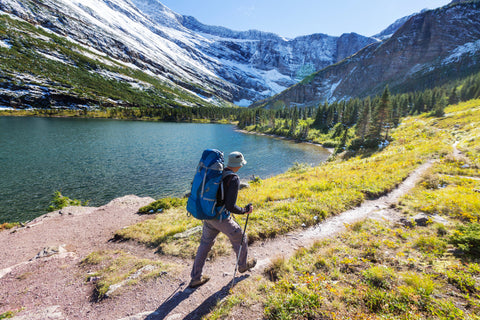
How Big is Glacier National Park
The wilderness of Glacier National Park is vast and rugged, covering roughly 1,580 square miles. Nearly a third of the park rests above the tree line, becoming rocky peaks and snowy summits. 21 miles of the park is shared with Canada’s Waterton National Park. There are more than 700 miles of hiking trails to explore in Glacier National park. Of the park’s 175 mountains, the tallest is Mt. Cleveland at 10,466 feet. The Middle Fork River is the lowest point at 3,215 feet.
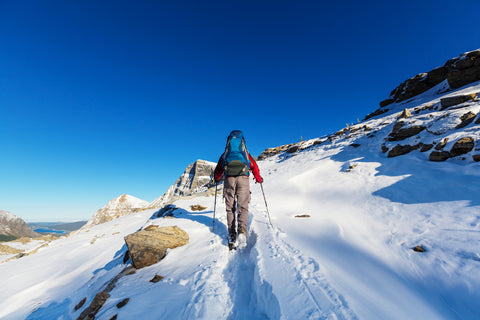
Glacier National Park Weather
The park straddles the Continental Divide, where warm Pacific air meets cold Arctic air. Because of this, the weather at Glacier is highly unpredictable. It can vary to great extremes. In the summer, the days are warm, reaching the late 80s or higher. The nights are chilly, dropping into the low 40s. Rain is always a possibility. The daily temperature average drops considerably as the seasons transition into fall and winter. Fall is cool and bright, perfect for hiking and leaf peeping. Snow can start as early as September (and sooner in the mountains). Winter is snowy and cold, but great for skiing and snowshoeing. Many parts of the park close for the season. In spring, snow melt and rain cause flooding in some areas.When did Glacier become a National Park
Glacier National Park is America’s 10th national park. It was established on May 11, 1910 by President Taft. The area had been used by man long before it became a national park. Human history can be dated as far back as 10,000 years ago, when the land was inhabited by healthy populations of Blackfeet, Salish and Kootenai Native Americans.
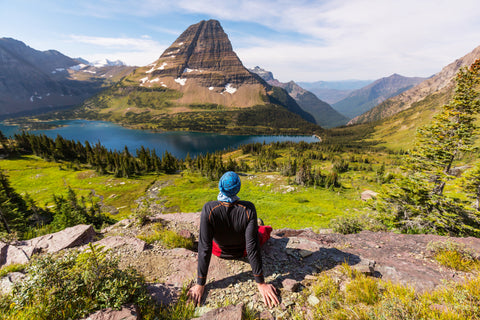
Things to do in Glacier National Park
Adventure awaits you in Glacier National Park! Our National Park Visitors Guide outlines some of the most popular park attractions and the best time to get out and experience them.
Going-to-the-Sun Road
Also called the Sun Road, this drive stretches across the park and crosses the Continental Divide. It covers 50 miles, reaching both East and West Entrances. Take in stunning views as you wind through the wilderness. There are overlooks and picnic areas along the road.
Grinnell Glacier
Located in the heart of the park, Grinnell Glacier is a must see! Rising up more than 7,000 feet, the cliffs are cool and misty. Below is Grinnell Lake, crystal clear and deep blue. The glaciers are all melting - see it while you can!
Iceberg Lake
Iceberg Lake is a popular destination at Glacier. Its clear, deep waters are perfect for taking a dip in after a long hike. Towering above the lake at more than 3,000 feet is Iceberg Peak. The best time to visit is July through September.
Logan Pass
For fields of wildflowers and an abundance of wildlife, hike out to Logan Pass. It’s the highest point in the park you can reach by car. The start of the Hidden Lake and Highline trails are here. It’s a year-round destination but get there early.
Waterton-Glacier International Peace Park
This part of the park is shared with Canada and has been dubbed a World Heritage Site. The area is rich in Native American history, especially Two Medicine Valley. This part of the park generally closes in winter, so best to visit Spring through Fall.
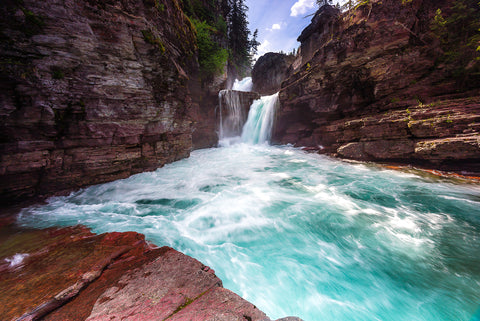
Virginia Falls
Virginia Falls is a stunning multi-tiered waterfall. The cool water is refreshing, particularly on hot summer days. The hike to the falls is relatively short and moderately rated. You’ll pass St. Mary Falls along the way. Summer and fall are the best seasons to visit.
Animals in Glacier
The wilderness of Glacier National Park is home to many different animals. The park is famous for the big mammals, including grizzly bears, wolverine and bighorn sheep. There are more than 200 species of birds here. There’s also fair selection of reptiles, amphibians and fish.
Goat Haunt
Known as the Gateway to the Northern Wilderness is Goat Haunt. It’s here you can access some of the most secluded hikes and areas in the country. Hikes include day and overnight trips. You can view the area on foot or take a boat tour.
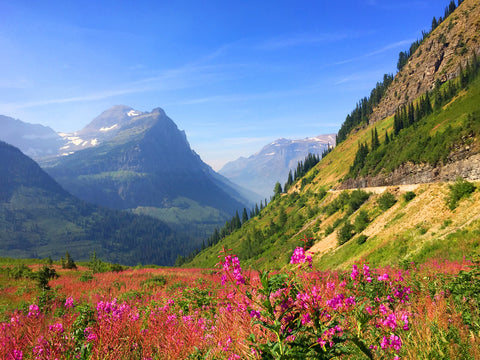
Swiftcurrent Mountain
Part of the Lewis Range, reaching a dizzying height of 8,440 feet, is Swiftcurrent Mountain. It is a popular place for hiking, climbing and mountaineering. Reach the top for spectacular 360° views from the Swiftcurrent Fire Lookout. Fall is an opportune time to visit.
Hiking Trails
With more than 700 miles of them, you’re sure to find a trail you love at Glacier National Park! Ranging from short and easy to long and challenging, there’s a hike for everyone. Meander through meadows, ramble around forests, skirt around glaciers, and summit snowy peaks.

When to go to Glacier National Park
Like all US National Park’s, Glacier is open year round but it has a peak season. The right time to visit is completely up to you. July and August are the busiest. The weather is warm and the park is fully open. It’s an excellent time for hiking, climbing and lake activities. September and October are gorgeous as fall colors flash across the park. It’s a good time to spy larger animals and hit the trails. Winter is November through April. You’ll find solitude and snow. It is a great time to hit the slopes for cross-country skiing. Parts of the park are starting to reopen in spring, May through June. It’s a popular time for hiking, biking, paddling and birdwatching.
Must-Have things to bring to Glacier
If you’re going to be out exploring the rugged wilderness of Glacier, List of Parks wants you to come fully prepared. We’ve listed some essential items you’ll need to bring along with you.
Sunscreen
Sunscreen is one of the most important items you can bring (SPF 50+). The sun's rays are powerful, and even more potent at higher elevations. Avoid sunburn and sun poisoning by applying often. It's also a great idea to bring a wide-brimmed hat and sunglasses.
Bug Spray
Don't let pesky insects bug you, bring repellent. The park is home to all kinds of insects, including flies, gnats, ticks and mosquitoes. Use bug spray or another repellent to keep bugs off you and your pets. Purchase before hand or at a park store.
Rain Jacket
Rain is common in Glacier National Park, especially in winter and spring. Avoid catching a cold or getting hypothermia by staying dry and warm. A waterproof rain jacket will help you do that. A jacket that folds up neatly will fit into your daypack best.
Clothing Layers
The weather along the Continental Divide is unpredictable and can change at a moment's notice. Stay warm and dry from the valley to the peaks by layering your clothing. Short-sleeved and long-sleeved shirts, shorts and sweats, extra socks and a coat are a good start.
Hiking Boots
The trails around Glacier are rocky, rugged and can be tricky. Save your feet and ankles by wearing sturdy hiking boots. Be sure your boots are broken in before bringing. Waterproof boots are always a plus. You might consider bringing hard-soled water shoes as well.
Water/Food
If you’re going out into the wilderness, it is imperative you bring water with you. You can bring extra water bottles or invest in a hydration filtration device to drink directly from streams. Food is important too. Store any food in bear boxes or canisters.
Binoculars
Binoculars are the best way to catch a glimpse of a grizzly bear, lynx, or moose from a safe distance. If you want to do any birdwatching, binoculars are a must. They also make it possible to see mountain climbers and mountaineers scaling the mountainsides.

Bear Spray
Both grizzly and black bear call the park home. Rangers recommend having bear spray in case you encounter these animals on the trails. Bear spray is available for purchase at the park. Make sure you know how to use it and keep it easily accessible.
First-Aid Kit
Accidents can happen. When they do, it is much better to be prepared. You should pack a small first-aid kit to take care of any minor injuries on-site so you can quickly get back to enjoying your trip. Be sure the kit contains unexpired supplies.
Park Maps
Glacier National Park is a wide, unforgiving wilderness. You don’t want to get lost out there. To prevent this, bring a physical copy of the park map. It is also a good idea to download a digital park map on your phone or GPS.
Where to stay in Glacier National Park
You’ve got options when it comes to staying overnight at Glacier National Park. Many people come just for the camping. There are thirteen fabulous frontcountry campgrounds plus backcountry campsites for backpackers. The park features cabins, inns and a rustic hotel. There are also a few luxurious lodges that feature spectacular views and all the amenities. You’ve also got options in towns around the park with plenty of private campgrounds, hotels, and cabins to choose from.
Food Nearby Glacier
Some of the best dining in the world is served at Glacier National Park - fresh, organic food alongside gorgeous and majestic scenery. You’ll find a bit of everything, like regional cuisine, American classics, desserts and coffee bars. The park has fine dining options, restaurants, snack shops, buffets, and cafés. It’s also just fine to bring your own snacks and meals.
Airports near Glacier National Park
Getting to Glacier National Park is a breeze if you choose to fly. Glacier Park International Airport is the closest option. It’s only 30 miles from the park’s West Entrance. Missoula International Airport, Great Falls International Airport, Lethbridge Airport are all great options being only a few hours from the park. Amtrak train services both East Glacier and West Glacier.

